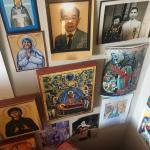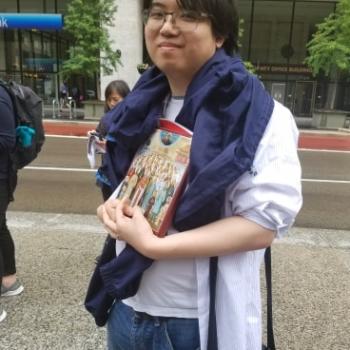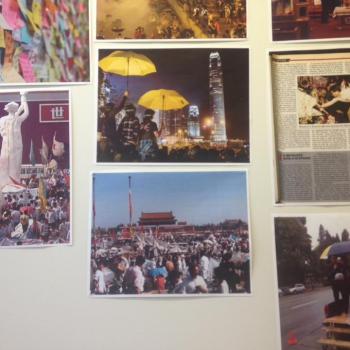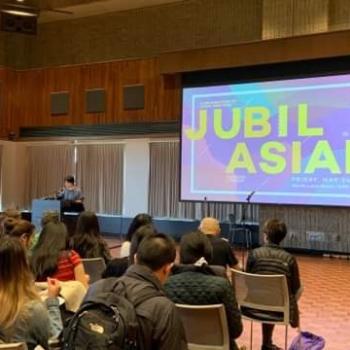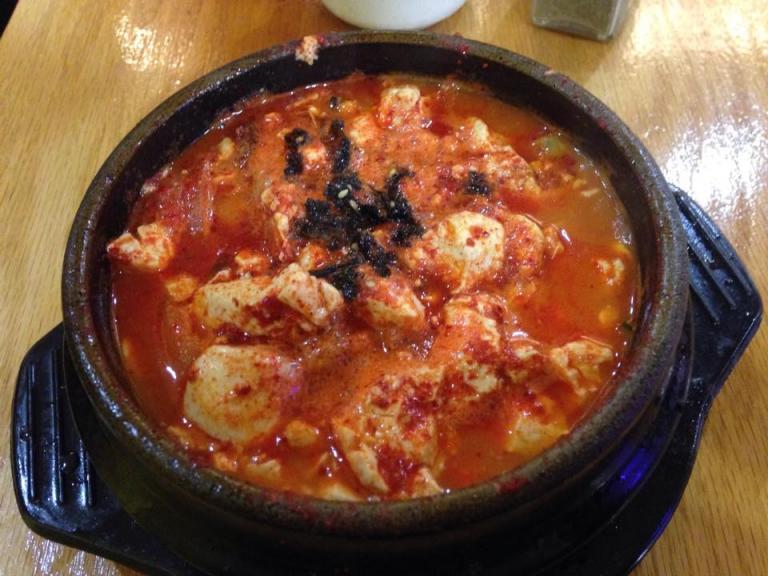
Two Palm Sundays ago, I found myself in Boston for the annual geographers’ conference. I am being specific about my discipline because, for all intents and purposes, I am a secular academic. Of course, I think and write theologically — which Christian doesn’t? — but I am, by training and profession, a social and cultural geographer. I go to geography conferences, and this one was being held where all the big conventions are held in Boston, out in Back Bay. I say that because a couple of years later, the big theology and religious studies annual conference was held there too, and I go to that one every year as well because I also write and teach Asian American religious studies and am involved in conversations on Chinese Christianities, among other postsecular questions that I engage in geography.
Around the time I started going to conferences in Boston, I discovered that a friend of mine, an Asian American evangelical who also researches the institutions and ideologies of the theological formation known as ‘Asian American Christianity,’ lives there. It turns out that she and her husband’s apartment was just up one of the train lines in an area called Brighton, and what was better, she offered free lodging in exchange for good conversation. I bit at the opportunity, and over the several times that I’ve gone over, our discussions on the state of Asian American Christianity and the dominance of evangelicalism over the field have been enlightening. When I finally finish the book I’m writing on Cantonese Protestants, it will in large part be because of the brunches we had when I was conferencing in Boston.
There is a street just down the hill from where my friend lives called Harvard Avenue; apparently, if you follow it out to Cambridge, you get to Harvard University. My friend told me that along this street, there are multiple Korean establishments, and in case I wanted to worship with ‘my people,’ there was also an Orthodox church. I explained to her in what must have sounded like the ravings of someone who was not quite all there that the Orthodox would not consider me one of them. I am in communion with Rome, and though our liturgies and spirituality are exactly the same, it would get into just a little trouble any Orthodox-not-in-communion-with-Rome to acknowledge that I am actually an Orthodox Christian. That is, of course, exactly what I am; in the oft-repeated words of a bishop in what used to be the Ukrainian Autocephalous Orthodox Church — now a part of the newly formed Orthodox Church in Ukraine:
Do not forget that the only church that really has preserved the continuity of the Kyivan tradition –is the Greek Catholic Church. All the Orthodox churches that exist here, unfortunately, broke with the tradition after 1686, when our church was subordinated to Moscow and rapidly assimilated with it. In the secluded environment of Galicia, the Greek Catholic Church was able to carefully nurture the Kyivan local tradition without being dissolved in Polish Catholicism. From the end of the XIX century, largely thanks to Metropolitan Andriy Sheptytsky, whose anniversary we are now celebrating, it started regaining those features of Ukrainian identity, which we all now need in Ukraine.
It’s true, of course. The children of the Union of Brest in 1598 were under the omophor of the Metropolitan of Kyiv, who along with his bishops (except for two in western Ukraine) came into full communion with the Latin Church while completely preserving the Byzantine tradition that had been passed down since the baptism of Kyiv beginning with the Holy Equals-to-the-Apostles Volodymyr and Olha in 989. We are Orthodox. We are also derided for the pact that started it all, the Union of Brest, as uniates. For this reason, I told my friend that I was so pleased that she recognized my Orthodoxy. Though it is a historically and theologically accurate depiction of my church, few others do.
Over the course of the conference, I found myself increasingly craving the Korean food of which my friend spoke. The geography conference is a famously long one, running up to five days with thousands of geographers descending yearly into a city centre to give papers. After giving my paper at this one, I was so burned out that I wandered into the Chinatown area to a random movie theatre to see the film that most Asian Americans were protesting for casting Scarlett Johansson into the role of an Asian, Ghost in the Shell. I was one of maybe five people, mostly Asians, in the theatre; the film, I later learned, had bombed, and if I were to be honest, I nearly fell asleep, except that ScarJo is one of the ‘manic pixie dream girls‘ of my adolescent cinematic fixations and that alone kept me from, as the Cantonese say, ‘visiting the Duke of Zhou,’ a mythic historic figure in early Chinese history who did much to consolidate the Zhou Dynasty (where all of what is ‘classic’ about ‘Chinese culture,’ at least the literary parts, can really be traced) and who was said to be an interpreter of dreams. To visit Zhou Gong, as we call him, is to cross the threshold into sleep, and the point is that I stuck with the dream on the screen.
Needless to say, I had not recovered when the next few days rolled around, and one day, I wandered out of Back Bay onto the train, got off at Harvard, and with the help of Yelp at the last minute, found a no-frills place for sundubu jjigae. For the uninitiated, the healing waters of this soup — a red pepper paste stew with a base of anchovy broth and a saturation with soft tofu, along with whatever else one wants to put in it (seafood, beef, and kimchi are the usual suspects) — were invented in Los Angeles’s Koreatown by a shrewd businesswoman who figured that all that protein would stuff any hungry college student full. Sure enough, the restaurant was populated by students from a variety of the nearby colleges, and I sat there too in a daze, craving nutrition to put me back together from my academic exhaustion.
That is when I noticed that across the street was the very Orthodox temple of which my friend had spoken. I noticed that it was a Bulgarian Orthodox church that held all of its services in English, and I remembered that not too long ago, I was speaking with some friends at Asian American InterVarsity here I work in Chicagoland, and they told me, upon finding that I am Eastern Catholic, that their Asian American evangelical friends had converted to Bulgarian Orthodoxy in Boston, and they have long been wanting to visit a church service. I noticed that while I was unavailable for Divine Liturgy the next day, as I would be flying back to Chicago to teach, I was free for the All-Night Vigil that was happening in two hours. I decided to go, after a nap.
I got there late, as one does when one naps and oversleeps, and only after I positioned myself next to the icons of Holy Mary of Egypt and the Holy Martyrs Sophia and her daughters Faith, Hope, and Love did I realize that it was Palm Sunday. To be quite honest, I was really struggling at that point in my Orthodox faith: it was my first year as a convert, and after shuffling between Ukrainian Catholic churches where I was always seen as an outsider and Orthodox temples where I always suspected I was being proselytized by Russophiles, I had settled for weekly mass at the Latin Church and not much prayer at home, and definitely no reader’s services because I didn’t know the tones well enough. I was fasting, sort of, in theory, but I was frankly tired — tired of the Kyivan Church, tired of having to commute to Orthodox and Greek Catholic services where I might or might not be welcome, tired of the Latin Church’s highly efficient liturgies (like a Starbucks on every corner, I described it), tired of evangelicals thinking that I was ready to be taken back.
I don’t know what it was about this Bulgarian Orthodox temple, but it felt like home. The tones felt familiar, and the best part was that because there was a competent kleros, I didn’t have to sing. I listened along, sang when I knew the tone, stood quietly in prayer. And then, suddenly, as if on cue, everybody got up and followed the priest out the door and downstairs to the main entrance. He began to pray, invoking saint after saint, and as he did, one woman began to sing, Lord have mercy! Lord have mercy! Lord have mercy! It was a haunting tone, one that I had never heard before, but as if the people knew what they were doing, they switched into Kyrie eleison! Kyrie eleison! Kyrie eleison! And then they went into what I thought was Russian: Gospodi pomiluj! Gospodi pomilui! Gospodi pomilui! And then another language I now know to be Arabic: Ya rab urham! Ya rab urham! Ya ra urham!
I honestly thought that they were doing that because it was a Palm Sunday procession. The truth is that that is called a lytia that occurs on Great Feasts at Vespers, and what the people were doing was moving through the Orthodox languages of English, Greek, Church Slavonic, and Arabic in a Greek chant of Lord, have mercy that is familiar to most people who have spent any amount of time in our tradition; there is even a YouTube recording of our monks in Univ doing it. What happened is, as I do, I sobbed, and soon after, I went to my friend’s chrismation in the Latin Church in Chicago and cried again. I suppose I would say that I was very moved by it, and in both cases, there was a mysterious sense of home that I felt. But the truth is that I wept because I was tired, and like the healing waters of the sundubu jjigae, the constant chanting uncorked the pent-up exhaustion with both church and academy that had been ready to explode.
In an almost ironic way, the happy mistaking of the lytia as somehow symbolic of a Palm Sunday procession in the western traditions opened me up to much more of what went on in the rest of the service. I would in fact say that a lot of what I do in the reader’s services that I pray now, especially the All-Night Vigils, are heavily influenced by what I experienced in what must be called this nourishing spiritual stew at this Vigil. I noticed, for example, that around the time of the canon in Matins, a line began to form at the iconostas where the priest was, and there, he took confessions till well after the service. For this reason, I try to go to confession as often as I can in conjunction with praying the Vigil, even if I don’t have much to say. I do the Greek chants of Lord, have mercy now. I generally think that Vigil is even more theologically important than Divine Liturgy too, especially for mystagogy.
Today, we return to Palm Sunday, at the end of yet another Great Fast. I can say now that this church is my home, and I can also say that I have found my vocation within academia. But having experienced such a profound moment of nourishment on the same feast day two years ago in Boston — both in the sundubu jjigae on Harvard Avenue and at the All-Night Vigil across the street — I have to say that this day is special for me. It is the day, as the tropars of the Matins canon build up to the Gospel at Divine Liturgy today, not only of the Lord riding into the city on the foal of an ass, but also (and perhaps more importantly) the moment when Mary of Bethany, the sister of Lazarus, breaks the alabaster jar over the feet of Jesus and anoints him with her hair, extravagantly worshipping her to the point of consternation by the disciples, including the thief Judas who says that the money to buy the perfume should have been given to the poor. But Mary, if are the other stories of Lazarus to be believed, was not wealthy. She gave of all she had and will be remembered, as the feminist theologian Elizabeth Schüssler Fiorenza never ceases to remind us of the church’s failure in this regard, wherever the good news of the kingdom is proclaimed. My reflection is that it can be said that this aroma nourished me on Palm Sunday two years ago, showing me that my truest home is in the Lord’s ocean of mercy and that his mission in entering the city, as the kondak for today says, is to ‘call Adam back.’ And so I returned.

